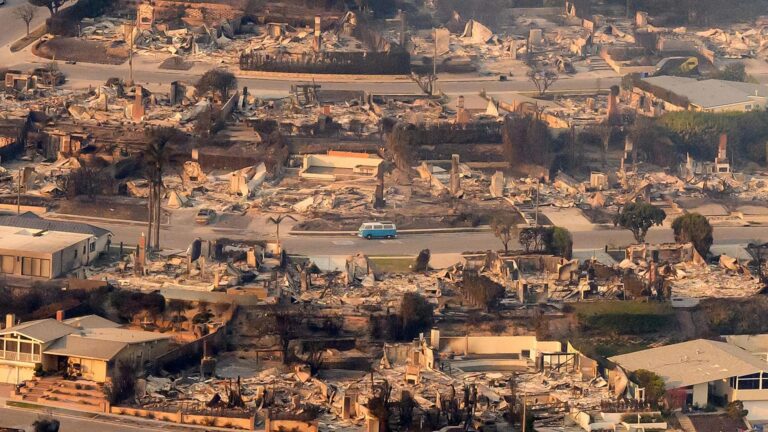Unraveling the Financial Fallout of the Los Angeles Wildfires: Who Pays the Price?
How the Los Angeles Wildfires Have Shaken Local Economies
The recent wildfires that swept through Los Angeles have inflicted more than just environmental devastation—they have severely disrupted the economic stability of affected communities. Property values in fire-ravaged neighborhoods have sharply declined, leading to a meaningful drop in property tax revenues that fund essential public services. Small enterprises,which often serve as the economic backbone of these areas,have suffered extensive losses due to damaged inventory,forced shutdowns,and diminished customer flow. The local labor market has also been destabilized, with many workers losing jobs and income, thereby increasing pressure on social welfare systems. Experts predict that economic recovery may take several years, disproportionately impacting low-income and vulnerable groups.
The financial responsibility for rebuilding and relief efforts is shared among various stakeholders, each facing unique challenges:
- Insurance Providers: Expected to disburse tens of billions in claims, potentially leading to higher premiums statewide.
- State and Local Governments: Tasked with funding emergency response, infrastructure restoration, and community aid programs, straining already limited budgets.
- Federal Assistance: Disaster relief grants and funds are critical but may fall short of covering all immediate and long-term recovery costs.
| Entity | Projected Financial Impact | Key Responsibilities |
|---|---|---|
| Insurance Companies | Over $40 billion | Claims settlements, policy revisions |
| State & Local Governments | Approximately $30 billion | Rebuilding infrastructure, emergency management |
| Federal Government | $15 billion plus | Disaster relief funding, grants |
Funding the Recovery: The Interplay of Government Aid and Insurance
In the wake of the Los Angeles wildfires, the enormous financial demands of recovery hinge on a combination of government assistance and insurance compensation.Federal and state agencies have activated substantial disaster relief programs, including FEMA’s Public Assistance and California’s Office of Emergency Services initiatives, aimed at restoring critical infrastructure and supporting displaced residents. While these public funds are indispensable, they represent only a fraction of the total resources needed for full recovery.
Insurance companies are responsible for compensating homeowners and businesses,but many policies fall short of covering the full extent of losses. Underinsurance and uninsured properties remain a significant concern, and the surge in claims is prompting insurers to reevaluate coverage terms and increase premiums, especially in wildfire-prone zones. The funding landscape can be summarized as follows:
| Source of Funds | Contribution to Recovery | Obstacles |
|---|---|---|
| Federal & State Aid | Infrastructure rebuilding,emergency response,community support | Budget constraints,administrative delays |
| Homeowners Insurance | Property damage compensation | Coverage gaps,rising premiums |
| Nonprofits & Private Sector | Supplementary aid,rebuilding assistance | Reliance on donations,limited reach |
- Federal programs focus on large-scale infrastructure and safety projects.
- Insurance payouts provide direct financial relief but are limited by policy terms.
- Charitable organizations address urgent needs, especially for marginalized groups.
Utility Companies and Corporate Responsibility in Wildfire Expenses
Utility providers have come under intense scrutiny for their contribution to wildfire-related damages.In the aftermath of the Los Angeles fires, accusations of negligence—such as inadequate maintenance of electrical equipment and failure to implement sufficient safety protocols—have sparked demands for increased corporate accountability. These companies face not only substantial legal liabilities but also mounting pressure to invest in infrastructure modernization to mitigate future risks. Consequently, the financial repercussions extend beyond immediate repair costs to include long-term expenses for legal settlements, upgrades, and compliance with stricter regulations.
The question of who ultimately bears these costs is complex. While utility firms shoulder significant financial responsibility, much of the expense is indirectly transferred to consumers through higher electricity rates. The financial dynamics can be outlined as follows:
- Utility Providers: Accountable for infrastructure liabilities and legal costs.
- Insurance Companies: Manage claims related to property damage but face premium hikes.
- Consumers: Experience increased utility bills and insurance premiums.
- Government Bodies: Provide emergency funding and recovery support, reallocating public resources.
| Party | Financial Obligation | Effect on Public |
|---|---|---|
| Utility Companies | Legal fees, infrastructure repairs | Increased electricity costs |
| Insurance Firms | Claims payments | Higher insurance premiums |
| Consumers | Rate increases, insurance costs | Elevated living expenses |
| Government Agencies | Disaster relief funding | Reallocation of public funds |
Building Resilience: Preventative Measures and Financial Strategies for California
California’s strategy to reduce the impact of future wildfires involves a extensive approach that integrates cutting-edge technology with robust policy reforms in emergency management and urban development. Investments in early warning systems, such as AI-driven satellite imagery and drone reconnaissance, are enhancing the speed and accuracy of fire detection. Additionally, expanding regulations that mandate defensible space around properties and critical infrastructure helps minimize fuel for fires. Public education campaigns on fire prevention and preparedness further empower residents to take proactive steps.
On the financial front, innovative insurance products and state-supported catastrophe funds are being developed to distribute wildfire-related costs more fairly. The following table highlights the roles of key participants in fostering financial readiness and wildfire mitigation:
| Stakeholder | Contribution to Financial Preparedness |
|---|---|
| State Government | Funds emergency response and supports wildfire insurance pools |
| Insurance Industry | Creates adaptive premium models based on evolving risk assessments |
| Local Communities | Implements fire-resistant building codes and infrastructure improvements |
| Homeowners | Engages in vegetation management and invests in fire-resistant home upgrades |
Conclusion: Reflecting on the Financial Aftermath and Future Outlook
As the full scope of the Los Angeles wildfires’ destruction becomes evident, the colossal financial toll—estimated to surpass $250 billion—raises pressing questions about fiscal responsibility. From insurance companies managing unprecedented claims to government bodies allocating emergency funds, the economic burden is distributed across multiple sectors. The coming years will be critical in shaping policies and recovery strategies, highlighting the urgent need for enhanced preparedness in the face of increasingly frequent and severe climate-related disasters.




